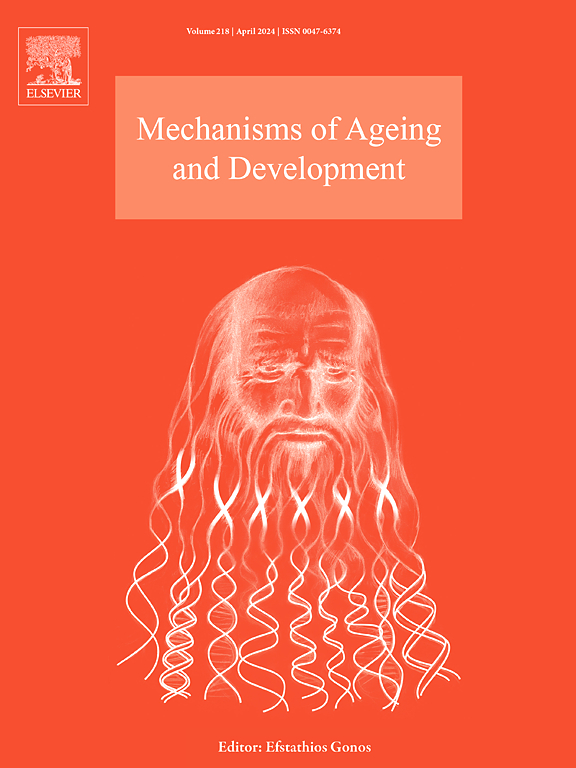Human astrocytes from healthy individuals and Alzheimer’s patients respond differently to Aβ1–42 oligomers, triggering distinct paths of reactivity and senescence
IF 5.1
3区 医学
Q2 CELL BIOLOGY
引用次数: 0
Abstract
Alzheimer’s disease (AD) is a neurodegenerative disorder characterised by cognitive decline, amyloid-β (Aβ) plaques, and neurofibrillary tangles. Aβ1–42 oligomers exert neurotoxic and pro-inflammatory effects. Astrocytes maintain brain homeostasis, and their dysfunction contributes to AD progression. This study investigates the impact of Aβ1–42 oligomers on primary human astrocytes from healthy individuals and AD patients. Our findings show that astrocytes from both groups internalise Aβ1–42 oligomers. In healthy astrocytes, internalisation enhances proteasome activity, whereas in AD astrocytes, it reduces it. Aβ1–42 oligomers induce calcium dyshomeostasis and mitochondrial membrane potential alterations in both groups. Interestingly, oligomers induce apoptosis in a subset of healthy astrocytes, while surviving ones become reactive and hyperproliferative, releasing neuroinflammatory and neurotrophic molecules. Conversely, Aβ1–42 drives AD astrocytes into senescence, characterised by increased β-galactosidase activity, p14ARF expression, senescence-associated secretory phenotype (SASP), and heterochromatin foci. Importantly, conditioned media from Aβ1–42-treated AD astrocytes, but not from healthy ones, cause death of differentiated SH-SY5Y neuron-like cells, suggesting that senescent astrocytes contribute to neurotoxicity. These findings reveal differential astrocytic responses to Aβ1–42 oligomers, emphasising the importance of astrocyte senescence in AD pathogenesis. This research offers insight into cellular mechanisms underlying AD and may support the development of innovative therapeutic strategies for neurodegenerative diseases.
健康个体和阿尔茨海默病患者的人类星形胶质细胞对Aβ1-42寡聚物的反应不同,引发不同的反应性和衰老途径。
阿尔茨海默病(AD)是一种神经退行性疾病,其特征是认知能力下降、淀粉样蛋白-β (a β)斑块和神经原纤维缠结。a - β1-42低聚物具有神经毒性和促炎作用。星形胶质细胞维持大脑内稳态,其功能障碍有助于AD的进展。本研究探讨了Aβ1-42寡聚物对健康人及阿尔茨海默病患者原代人星形胶质细胞的影响。我们的研究结果表明,两组的星形胶质细胞都内化了Aβ1-42低聚物。在健康的星形胶质细胞中,内化增强蛋白酶体活性,而在AD星形胶质细胞中,内化则降低蛋白酶体活性。a - β1-42低聚物诱导两组钙平衡失调和线粒体膜电位改变。有趣的是,低聚物在一部分健康星形胶质细胞中诱导凋亡,而存活的星形胶质细胞变得反应性和超增殖,释放神经炎症和神经营养分子。相反,a - β1-42驱动AD星形胶质细胞衰老,其特征是β-半乳糖苷酶活性、p14ARF表达、衰老相关分泌表型(SASP)和异染色质灶增加。重要的是,来自a β1-42处理的AD星形胶质细胞的条件培养基,而不是来自健康的星形胶质细胞的条件培养基,导致分化的SH-SY5Y神经元样细胞死亡,这表明衰老的星形胶质细胞有助于神经毒性。这些发现揭示了星形细胞对a - β1-42寡聚物的不同反应,强调了星形细胞衰老在阿尔茨海默病发病中的重要性。这项研究为阿尔茨海默病的细胞机制提供了见解,并可能支持神经退行性疾病的创新治疗策略的发展。
本文章由计算机程序翻译,如有差异,请以英文原文为准。
求助全文
约1分钟内获得全文
求助全文
来源期刊
CiteScore
11.10
自引率
1.90%
发文量
79
审稿时长
32 days
期刊介绍:
Mechanisms of Ageing and Development is a multidisciplinary journal aimed at revealing the molecular, biochemical and biological mechanisms that underlie the processes of aging and development in various species as well as of age-associated diseases. Emphasis is placed on investigations that delineate the contribution of macromolecular damage and cytotoxicity, genetic programs, epigenetics and genetic instability, mitochondrial function, alterations of metabolism and innovative anti-aging approaches. For all of the mentioned studies it is necessary to address the underlying mechanisms.
Mechanisms of Ageing and Development publishes original research, review and mini-review articles. The journal also publishes Special Issues that focus on emerging research areas. Special issues may include all types of articles following peered review. Proposals should be sent directly to the Editor-in-Chief.

 求助内容:
求助内容: 应助结果提醒方式:
应助结果提醒方式:


